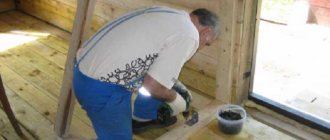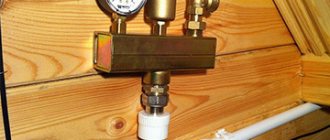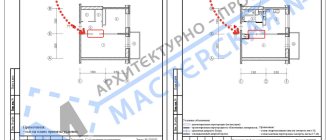Anyone who has decided to build or install a finished bathhouse on their private property must understand that it is very important to properly care for this premises. A common problem faced by bathhouse owners is condensation in the dressing room. A wet surface is not only unsightly and unpleasant, but also dangerous for the structure of the structure.
Formation of condensation on the walls and ceiling in the dressing room
Condensation on the lining in the bathhouse
To avoid such a nuisance, you should carefully study the causes of condensation and methods of dealing with it.
Why does condensation occur in the dressing room and how to get rid of it?
Why does condensation form in the dressing room?
This question worries many. Any Russian bathhouse has a room called a dressing room. In it, as a rule, people relax after the steam room, store things, other various attributes and a small fuel reserve for the stove. However, very often the condensation that forms on the walls and ceiling in the dressing room becomes a huge problem, since it is not easy to get rid of it due to the fact that the dressing room directly communicates with the “wettest” rooms. Building a bathhouse on your country property is one thing, but proper care of it is something completely different. The problem of high humidity with the formation of condensation, which settles on the surface of the walls and ceiling of the bathhouse, leads to the appearance of mold and mildew on them, and wet walls from excess moisture are susceptible to very rapid destruction of building structures and rotting of wooden parts.
It is rare that a stove is installed in the dressing room, which simultaneously performs the function of heating the room and providing natural ventilation through it. In all other options, to get rid of condensation in the dressing room, the most optimal and convenient methods of ventilating the bath should be provided.
Why is condensation dangerous?
Dampness and high humidity, first of all, are a favorable environment for the development of various microorganisms, fungi, and mold. Wet walls and ceilings often lead to the formation of rot, which can cause the bathhouse to fall into disrepair. Just as mentioned above, all this can adversely affect human health.
Why is there ventilation in a bathhouse?
In this case, the ventilation system in the bathhouse is very important. But let’s not expand too much, going into lengthy, uninteresting discussions, but instead let’s look at one specific example.
A person in a bathhouse is essentially in a room with just a huge amount of hot steam. And, of course, he inhales this steam. But people, as we know, breathe oxygen, exhaling the notorious carbon dioxide instead. And if the air exchange is insufficient, then the person steaming after a while will easily get burned.
For this reason, bath ventilation should be extremely effective and fully comply with all stated requirements (we’ll talk about them a little later). There are several types of ventilation systems, and all of them will be discussed in this article. And if you familiarize yourself with their features, you will be able to choose the most suitable option for yourself!
Ways to get rid of condensation in the waiting room
There are different methods for getting rid of condensation in the dressing room. Among them, several can be noted that allow us to remove this negative factor.
- Ventilation. This method is the simplest and is used when it is not possible to use other methods. Ventilation allows you to remove some of the moist air from the room. This leads to a decrease in overall humidity and stops the formation of condensation. To ventilate the dressing room, just open the front door for a while. The walls and ceiling must be wiped free of moisture.
- Natural ventilation system. With this method, air ducts are installed in the room from below and above, which ensure natural air flow. For effective ventilation, the diameter of the air ducts must be at least 10 cm.
- Installation of forced ventilation systems. Even the smallest forced ventilation system will remove moist air from the room, thereby eliminating the main cause of condensation. In this case, small fans are installed in the air ducts, which ensure continuous movement of air flow. Fans are installed in the lower and upper air ducts.
- Thermal insulation. In this case, thermal insulation panels are installed in order to eliminate the cooling of the internal cladding panels of the walls and ceiling.
- Installation of an additional stove or fireplace. One of the most difficult and expensive ways to combat condensation. This provides additional heating of the room and walls, thereby eliminating the cause of condensation.
How to get rid of the condensation that has formed on the walls and ceiling in the dressing room in simple and effective ways? To answer this question, you can offer several options and actions that will help reduce the level of condensation in the bath:
- It is recommended to make round or rectangular holes for ventilation under the very ceiling, in the opposite walls in the dressing room. The holes must have rectangular sides or a diameter of at least 10 cm.
- Low-power electric fans of several W can be installed in the holes provided for ventilation. These fans will forcefully pull excess moist air outside.
- In winter, if necessary, the vent holes are covered with dense material - a cloth or a sponge while heating the bathhouse - so that the room does not cool down, and then after all water procedures are completed, the holes are opened again.
- The ceiling of the dressing room can also be dried by opening the doors from the heated steam room. Thus, the released warm air will move from one room to another and, of course, will rush upward. Naturally, it is recommended to carry out this activity after completing the main process of staying in the bathhouse.
- It is not recommended to paint the waiting room and steam room, varnish it, or dry some of the wooden products. If necessary, “windy” areas are treated with emery cloth.
- The wooden ceiling in the dressing room can be impregnated with antiseptic, antifungal and moisture-resistant compounds that will protect it from blackness, blueness and other unpleasant manifestations. You can apply impregnation to the ceiling using a roller or brush in several layers - for reliability.
- It is elementary and not superfluous, after you have steamed, to take an ordinary mop with a rag and wipe the ceiling in the dressing room from the drops of water that have formed on it - condensation.
- The reason for increased dampness in the dressing room may also be the presence of moisture under the floor, which drains during washing and accumulates there, and then evaporates through cracks in the floor and settles on the ceiling.
- Under the floor in the dressing room, it is recommended to install several sheets of galvanized iron with a slope in one direction so that water drains and does not accumulate in the underground.
A new bathhouse requires new technologies!
When building a new bathhouse, new technologies can be used. The wooden lining inside can be treated with special antiseptics that do not emit harmful fumes. You can also impregnate the wood with the antiseptic composition “Senezh Ecobio” before construction, protecting the deep layers of wood. After this, treat with a special protective coating “Senezh Sauna”, it has increased moisture resistance and an antimicrobial effect. At the same time, there is no need to paint, varnish, or dry wood structures. It is recommended to lay ceramic tiles on the floor, which are not susceptible to rotting and mold and will last a very long time. If, when building a bathhouse, you properly install ventilation and treat the wood with modern materials, then these actions can minimize the release of condensation on the walls and floor, which will lead to long-term operation. Take care of your health!
Remedies
There are different methods for getting rid of condensation in the dressing room. Among them, several can be noted that allow us to remove this negative factor.
- Ventilation. This method is the simplest and is used when it is not possible to use other methods. Ventilation allows you to remove some of the moist air from the room. This leads to a decrease in overall humidity and stops the formation of condensation. To ventilate the dressing room, just open the front door for a while. The walls and ceiling must be wiped free of moisture.
- Natural ventilation system. With this method, air ducts are installed in the room from below and above, which ensure natural air flow. For effective ventilation, the diameter of the air ducts must be at least 10 cm.
- Installation of forced ventilation systems. Even the smallest forced ventilation system will remove moist air from the room, thereby eliminating the main cause of condensation. In this case, small fans are installed in the air ducts, which ensure continuous movement of air flow. Fans are installed in the lower and upper air ducts.
- Thermal insulation. In this case, thermal insulation panels are installed in order to eliminate the cooling of the internal cladding panels of the walls and ceiling.
- Installation of an additional stove or fireplace. One of the most difficult and expensive ways to combat condensation. This provides additional heating of the room and walls, thereby eliminating the cause of condensation.
Waiting room ceiling
If you have an attic, it is recommended to choose a false ceiling. If small items, such as brooms and basins, will be stored there, then it is better to opt for a flat ceiling.
Ceiling insulation is carried out according to similar principles used for floor insulation. However, the choice of insulation here is more varied and allows for both cheap and expensive materials. Basalt wool is considered the best option, as it is characterized by high fire safety and moisture resistance.
The main purpose of ceiling insulation is to reduce heat loss, as heated air is directed upward. Based on this goal, we use foiled polyethylene to reflect heat, the seams of which are treated with reinforced tape. We attach polyethylene to wooden blocks to the ceiling. We cover the ceiling with 120 mm clapboard.
How to eliminate the causes of condensation in the dressing room?
One of the easiest ways to remove condensation is to coat surfaces exposed to hot steam with heat-insulating paint. When the bath warms up, the upper part of the walls and ceiling will heat up faster, which will significantly reduce the amount of moisture formed on them. It is also necessary to insulate the room from the outside, moving the dew point closer to the outer layer of load-bearing walls.
If you're willing to spend a one-time investment, you can purchase a dehumidifier that will do all the work for you. It will eliminate excess humidity, which causes condensation, which means that the windows will no longer sweat, the walls will not get wet, and the ceiling will not drip.
Upgrading the ventilation system will help get rid of condensation in the dressing room in winter. One of the easiest ways is to create ventilation holes in the ceiling - strictly opposite each other at opposite ends of the room. This way, excess steam and humidity will escape from the room, and you won’t have to worry about drafts.
Low-power fans can be installed in ready-made ventilation holes to help cope with dampness. Do not forget that during procedures in the steam room, all ventilation holes must be closed with thick fabric or special valves until the end of the session.
Many craftsmen advise installing vaults for water drainage. If you have a so-called leaky floor - gaps are left between the floorboards, then the vault is installed directly under the floor itself and should have a slope towards the drain hole.
In the case of floorboards tightly fitted to each other, the drain is installed in the lowest place. It is imperative to insulate the floor with waterproofing and periodically check its integrity. Craftsmen advise installing valves in the drain to prevent the appearance of an unpleasant odor.
Installing heating devices in the dressing room also helps reduce humidity and eliminate condensation factors. A stove or fireplace heated with wood or heated by electricity will dry the air from steam and prevent condensation from forming.
Don't forget about safety precautions. Any heating devices must be installed strictly according to the rules, because their presence increases the risk of fire. Do not leave stoves and fireplaces unattended, extinguish the coals before leaving and turn off the power from the mains.
For more information on installing heating devices and ventilation in the dressing room, see below.
Why does condensation occur in the dressing room and how to get rid of it?
This is done with the help of “chairs” for sexual transfers. It is necessary to calculate so that the furnace vent is below the poured floor. Now you can start pouring, and you need to make sure that there is a slight slope in the direction of the drain pipe. Let's start installing the stove.
All that remains is to lay the floors. To do this, we insulate the concrete with any suitable material, and install logs on top. We lay boards on the joists, but with such a condition that there is a small gap between them, about 10-15mm. This is where the water will flow.
Now the final stage is lining the walls and ceiling with clapboard, but there is nothing complicated here.
By following these simple steps, you can ensure that condensation drains into the drain, and thereby get rid of its accumulation on the walls.
Bathhouse - Getting rid of condensation on the walls in the bathhouse
Many people love to wash in a Russian bath. Why not build it on your country plot? But it’s one thing to build it, and quite another to take care of it. Many bathhouse owners are faced with the problem of high humidity, which settles on the walls and ceiling and leads to wood rotting and the formation of mold and mildew on the walls. Condensation flows down the walls without drying completely, and this causes irreparable damage to building structures.
Is condensation dependent on ventilation?
Condensation on the walls in the dressing room is a consequence of improper installation of ventilation. It is known that in the washing room and steam room the air temperature is much higher than in the dressing room. When people leave the steam room, all the steam goes into the room and settles on the walls, flowing down in streams. All this happens due to temperature changes. After a certain period of time, the bottom boards have to be replaced, as they begin to rot, become overgrown with fungus, and an unpleasant musty smell appears. It is necessary that the room has a window with a window, in addition to the main ventilation, this will make it easier to dry the walls and reduce condensation.
Why does condensation form in the dressing room?
There are many reasons for the formation of condensation in a bathhouse, the main ones being:
- Insufficient ventilation of the room;
- Increased humidity in the space;
- Improper thermal insulation of walls, floors and ceilings, as well as windows and doors; Scheme of thermal insulation of walls in a bathhouse
The process of installing insulation on the floor
- Regularly high air temperatures, which especially affects the occurrence of condensation in winter;
- Incorrect and ill-conceived ventilation in the bathhouse.
Ventilation hole diagram
All these factors negatively affect the level of condensation, forming moisture on the walls, ceiling and floor, which can adversely affect the quality and strength of the materials from which the bath vaults are built.
Scheme of condensation formation in the dressing room
To avoid side effects from exposure to condensation on surfaces, you should know what to do to save the room. Special tools, equipment, or simply proper care of the bathhouse space will help with this.
The danger of condensation for a bath
Condensation is not just innocent moisture on surfaces. Due to this phenomenon, the following may occur:
- Rotting of materials;
- Fungus formation on different surfaces;
- Destruction of building materials from the inside and, as a result, the emergency condition of the bathhouse;
- Dryness of wooden beams, as well as loss of their quality and overall structure.
All these moments are extremely unpleasant for those who have erected a wonderful structure for a pleasant pastime in their private sector.
Scheme of insulation of various rooms in the bathhouse
However, there is no need to sound the alarm, if you think in detail about the methods of dealing with the “disease” of a room with high humidity, then everything will work out and you can forget about this problem forever.
Causes
Many people have noticed that water droplets form on a glass jar that is sterilized over steam (the jar sweats). After heating the jar, droplets stop appearing. The same thing happens if you bring a cold metal spoon to the spout of a boiling kettle. After some time after heating the spoon, droplets will stop forming.
The main reason for the formation of condensation is the fact that heated water vapor, which falls on a colder surface or in a colder environment, begins to form water in the form of small drops.
It also rains for the same reason. Heated water vapor enters the upper (colder) layers of the atmosphere. In the same way, moisture appears on the walls and ceiling of the dressing room. At the same time, the walls and ceiling become wet and damp. The accumulated drops of water drip down onto the floor, making it wet.
There are several reasons for the appearance of condensation in the dressing room:
- High indoor humidity. Moist air collects in poorly ventilated areas, causing moisture and dampness.
- Warm moist air hitting the cold walls of the bathhouse.
- Lack of ventilation in the room or its insufficient functioning.
In addition, the reason for the appearance of condensation is the lack of necessary thermal insulation between the inner coating of the walls of the dressing room and the outer wall of the bathhouse . As a result, the coating is constantly cooled. All this leads to the constant presence of condensation. It deteriorates the properties of the material from which the building is constructed, reducing its durability. Drops of water falling on electrical wires can cause a short circuit.
One of the reasons for the formation of condensation may be the flow of water under the floor directly from the bathhouse itself. Therefore, it is necessary to make sure that there is no moisture entering through the subfloor. If there is a leak, everything must be done to eliminate it.
This unpleasant phenomenon may be accompanied by rotting of the materials from which the bathhouse is built. These are mainly wooden parts of the building. A large amount of fungus and mold may appear on the walls and ceiling, as well as under the cladding. Rust forms on metal surfaces.
Ventilation system in the dressing room
The functioning of ventilation in the dressing room is ensured both by the flow of air through window and door openings, and through special vents made in the wood. Air flow is regulated by special sliding plugs.
The size of the vents is usually 15-20 centimeters. The lower vent is located approximately 50 centimeters from the floor and not far from the combustion chamber. The second vent should be on the opposite side, approximately 2 meters from the floor level.
Forced ventilation of the room can be created using a fan installed in the exhaust hole. This device will make the removal of moist air more intense.
How to eliminate the causes of condensation in the dressing room?
One of the easiest ways to remove condensation is to coat surfaces exposed to hot steam with heat-insulating paint. When the bath warms up, the upper part of the walls and ceiling will heat up faster, which will significantly reduce the amount of moisture formed on them. It is also necessary to insulate the room from the outside, moving the dew point closer to the outer layer of load-bearing walls.
If you're willing to spend a one-time investment, you can purchase a dehumidifier that will do all the work for you. It will eliminate excess humidity, which causes condensation, which means that the windows will no longer sweat, the walls will not get wet, and the ceiling will not drip.
Upgrading the ventilation system will help get rid of condensation in the dressing room in winter. One of the easiest ways is to create ventilation holes in the ceiling - strictly opposite each other at opposite ends of the room. This way, excess steam and humidity will escape from the room, and you won’t have to worry about drafts.
Low-power fans can be installed in ready-made ventilation holes to help cope with dampness. Do not forget that during procedures in the steam room, all ventilation holes must be closed with thick fabric or special valves until the end of the session.
Many craftsmen advise installing vaults for water drainage. If you have a so-called leaky floor - gaps are left between the floorboards, then the vault is installed directly under the floor itself and should have a slope towards the drain hole.
In the case of floorboards tightly fitted to each other, the drain is installed in the lowest place. It is imperative to insulate the floor with waterproofing and periodically check its integrity. Craftsmen advise installing valves in the drain to prevent the appearance of an unpleasant odor.
Installing heating devices in the dressing room also helps reduce humidity and eliminate condensation factors. A stove or fireplace heated with wood or heated by electricity will dry the air from steam and prevent condensation from forming.
Don't forget about safety precautions. Any heating devices must be installed strictly according to the rules, because their presence increases the risk of fire. Do not leave stoves and fireplaces unattended, extinguish the coals before leaving and turn off the power from the mains.
For more information on installing heating devices and ventilation in the dressing room, see below.
Methods for removing moisture from pipes
The solution to the problem of foggy pipes depends on the cause of its occurrence, location, condition of the water supply and other factors. In most cases, you can cope with the problem yourself by adjusting ventilation or thermal insulation. However, sometimes radical measures are required - replacing the water supply, repairing plumbing fixtures, and faucets. It is better to entrust such work to a specialist.
Thermal insulation
Thermal insulation of cold water pipes will help get rid of condensation and prevent its formation in the future.
Heat insulating tubes
You can carry out insulation yourself using modern building materials, for example, energyflex, thermoflex, etc. Such materials are easy to install, safe, and affordable. In addition, they effectively cope with the task.
Let's consider the procedure for doing thermal insulation with your own hands:
- Dry the pipe thoroughly.
- Cut the insulation tube lengthwise.
- Place the energyflex on the water supply.
- Fill the seam and joints with glue or seal with tape to ensure complete tightness and insulation.
- Cover the insulation with spray paint so that it does not stand out from the overall design of the room.
Thermal insulation of pipes is a sure and effective way to avoid the formation of condensation and related problems
Plastic pipe
As an alternative to special insulation, use a regular plastic pipe of larger diameter. Make a longitudinal cut on it and carefully place it on the water pipe. Fill the free space with polyurethane foam. This method is simple, fast and cheap, but the service life of the structure is very limited.
putty
You can create thermal insulation using putty. Work order:
- Dry the surface, clean it from dust, debris and rust.
- Degrease the pipe with a solvent and then treat it with a special anti-corrosion agent.
- Apply the first layer of epoxy putty and wrap with fabric or twine.
- Apply several layers to achieve the desired insulating effect.
- After the putty has completely dried, treat the surface with coarse sandpaper and paint.
Special preparations
The simplest, fastest and most effective method of insulation is a special paint, which, after drying, turns into a polymer coating with thermal insulation properties. These products include: “Isollat”, “Corundum”, “Astratek”, “Teplomet”, “Bronya”, etc.
For thermal insulation, use special liquid compounds that are applied to pipes in several layers and create reliable protection
Application procedure:
- Wash the surface from dust and dirt, and then dry well.
- Sand the pipe with sandpaper to remove rust, and then coat it with a degreasing compound.
- Apply the selected product with a brush or spray in 3-5 layers. Be sure to dry the surface thoroughly before re-processing. Cover the top layer with a special protective varnish.
Ventilation
To solve the ventilation problem, follow a simple algorithm:
- Check the vent for debris, dust, and cobwebs. Remove all contamination and clean the well.
- Install a new grille or a special fan to create forced ventilation. This will solve the problem with condensation and high humidity.
- Leave the bathroom or toilet door open at night to create natural ventilation.
To normalize the humidity in the bathroom, install a forced-air fan in the vent
Other methods
Moisture absorbers will help remove condensation in the bathroom or toilet. The simple device is a plastic box containing an absorbent substance. It will help solve the problem of condensation, dampness, high humidity, and also reduce the risk of fungus.
Condensate traps will help deal with water droplets on the surface of the pipeline. Devices are classified into thermostatic, float and combined. They are installed at the outlet of the air heater or water heater, and the operating principle is based on the evaporation of excess moisture in the system.
If the cause of the problem is a faulty faucet or a leaking toilet cistern, then it is necessary to repair or replace the plumbing
Options for getting rid of condensation
Scheme of insulation of bathhouse walls from the outside Formation of condensation in the pipe
Today, every owner of a summer cottage with a bathhouse built on its territory can afford to choose the most appropriate way to combat condensation in the premises.
Ventilation
If it is not possible to use more modern methods, then you should at least let fresh air into the bathhouse space. This is one of the ways to get rid of condensation in the dressing room in winter.
It is clear that during your stay the windows and entrance doors will not be opened, because you can freeze and ruin the essence of the steam room.
Detailed diagram of the ventilation device in the bathhouse
Therefore, it is better to make the moment of relaxation habitual, and when everyone has left the bathhouse space, carry out the following procedures:
- Open the dressing room door.
- Wipe all surfaces thoroughly with a mop or cloth.
- Leave the door open until the moisture has completely left the room.
- Then you should again go over all surfaces with a dry cloth to eradicate sources of corrosion from the open spaces of the room.
Installation of fans
This is an ideal option that will help ventilate the space without unnecessary effort. Even the most primitive ventilation systems will help remove the moisture that has formed from the bathhouse, which will ensure normal air circulation in the room and get rid of condensation.
Ventilation hole in the dressing room
To ensure that the cost of financial resources does not exceed the norm, you can buy the most inexpensive ventilation systems. They will have to be changed periodically, but they will serve their time, performing their functionality efficiently.
Installation of a fan in a bathhouseDiagram of a forced ventilation device in a dressing room
It is worth remembering that when visiting the steam room, the ventilation holes should be covered with thick fabric or special valves. After the end of the session, be sure to open the ventilation units to remove excess moisture. Watch the video to learn where mold and mildew come from in a bathhouse.
Proper thermal insulation and design of water outflows
Sometimes eliminating condensation becomes possible after installing proper thermal insulation and vaults for water drainage. Often, condensation occurs when water flows beneath the surface of a structure.
Accumulating in the facade of the building, the liquid begins to evaporate, as a result of which moisture appears on the surfaces of the floor, ceiling, and walls. If the thermal insulation of walls, floors and ceilings is not done correctly, condensation may appear due to incorrect thermoregulation in the space. Drafts, blowing, cracks can negatively affect the overall atmosphere in the room. Therefore, it is worth periodically checking for damage to the insulation material. If defects are found, the thermal insulation system should be corrected or reconstructed.
Bake
If it is possible to install a stove or fireplace in the dressing room, then this solution will be ideal and the construction of the bathhouse will last for many years. A stove or fireplace heated with wood or electricity will help dry the air and eliminate factors that can cause increased condensation.
Drawing of a ventilation device using a sauna stove
It is worth remembering that if a stove is installed in the bathhouse, you should carefully ensure that safety precautions are observed at the proper level. After all, the presence of such devices increases the risk of ignition. Therefore, you should never forget to turn off the fireplace or put out the coals in the stove to avoid trouble.
Existing options for ventilation in the bathhouse
Condensation in the dressing room can play a cruel joke on private sector owners. Constant moisture on the walls, ceiling and floor can begin to destroy the structure of a wooden bathhouse from the inside, which entails enormous costs. Therefore, it is worth approaching the issue of caring for the bathhouse with full responsibility. If you properly get rid of condensation, then it cannot harm your favorite place for intimate conversations, health procedures and just a pleasant pastime.
How to remove?
Not all builders perform their tasks efficiently, and home craftsmen often make mistakes
In addition, the finishing “pie” can deteriorate over time: it is damaged by careless repairs and improper use. Finally, a house with condensation in the attic may be inherited from the previous owners, and this problem must be solved
First of all, if condensation collects in the attic, you need to carefully study the air movement. Normally, it should be continuous and cover the entire volume of the room.
The attic should be inspected by a professional with a thermal imager; his consultation will allow him to detect any deviations from the norm. When the picture is clear, you need to check the roof formation diagram. Most likely you will need:
- change the location of the attic window;
- strengthen the insulation layer;
- make additional ventilation openings.
If you know that the attic space is getting wet due to the use of low-quality materials, you will have to change the problematic structure. The best replacement would be a membrane layer that will not allow condensation to form: water calmly comes out, but does not penetrate inside, and the lint-covered layer prevents drops from forming on the surface. It happens that even after replacing the waterproofing, the attic in a private house sweats. Then there is nothing left but to adjust the sheathing and vapor barrier layer. After all, they can also interfere with the normal movement of air masses and provoke the accumulation of dampness.
When the perforated soffits on the eaves are properly prepared, when the insulating layer is laid on the rafters themselves and under the metal tile sheathing, then the insulation will not become damp. There is a popular myth that venting causes heat loss in the attic during the winter months. In reality, the situation is different: the cause of excessive cooling is associated with poor thermal insulation.
When it is done poorly, the dew point ends up inside the roofing “pie” or on its surface. Therefore, moisture is deposited continuously, and the ceilings begin to rot.
Ventilation of the attic space is also necessary during the cold months, since otherwise icicles will appear inside, then fungi and mold will form. It is necessary to make holes of a certain size for air passage. Excessively small openings have almost zero efficiency. According to experts, for 500 sq. m of total area, you need to create 1 m2 of holes for ventilation. This proportion simultaneously allows:
- guarantee fresh air;
- get rid of condensed moisture;
- prevent hypothermia in a cold attic or attic.
The fight against dampness under an unheated wooden roof has its own characteristics. It is unacceptable to cover the rafters, as well as the sheathing. If they are sutured, it is necessary to provide gaps to support air circulation. Under sheets of slate or ondulin, laid without vapor barrier and wind barrier, there is no need to carry out additional ventilation work: air flow moves freely through the roof waves.
Placing ventilation passages inside the gables will help increase the ventilation efficiency of gable roofs. When using stone fronts or the impossibility of refusing to fit materials tightly, it is necessary to prepare holes in the walls (minimum 0.2% of the total floor area).
Elimination of dampness is possible with the help of more economical materials, that is, using a standard grille: one copy of it is turned with the holes downwards, the other requires periodic adjustment. A mosquito net becomes a reliable barrier against the penetration of various harmful insects.
It is also possible to avoid the appearance of wet areas under a hip roof, but a different technological method is used for this. The inlet for fresh air is located at the bottom of the hem, and it should exit near the ridge. Overhangs lined with wood are formed from loosely placed timber, which separates the gaps by fractions of a centimeter. Plastic linings are equipped with holes for air access.
The holes in the roof ridge should be brought as close together as possible. Often, continuous soffits are installed under the eaves, which are equipped with a thin mesh screen. The cells of such networks must be plastic or aluminum, otherwise there is a high risk of corrosion. It is advisable to equip the spaces between the rafters with vents, and the openings are arranged so that there is no air pollution and its movement is not complicated.
Chemical elements that help get rid of condensation
Chemical industry products help protect cold water supply pipes from condensation: Stermizol, Corundum, Teplomet and others.
The use of these insulating mixtures involves the following steps:
- The pipe is cleaned of dirt and rust.
- Apply a layer of primer for better adhesion of the insulation to the surface and leave to dry.
- Using a roller, brush or spray, cover the surface with a protective mixture. The most effective is the application of 5 layers of insulation, and each layer must dry thoroughly before the next application. The optimal drying time for such mixtures is about 1 hour.
- A special fixer helps to extend the service life of a thermally insulated pipeline, which at the same time makes the pipes more attractive.
Which method to use to combat condensation on cold water supply pipes depends on the reasons for the formation of this phenomenon and the specific operating conditions
Condensate drainage device - condensate drain
A float condensate drain is used to drain the formed condensate automatically. This device is installed at the outlet of the apparatus providing heat exchange, including water heaters and air heaters. Through this technical device, the water accumulated in the system simply evaporates.
Steam traps are divided into three main groups:
- Combined type devices.
- thermostatic.
- Float
The main advantages of a device of this type are the following:
- High degree of reliability.
- Excellent performance indicators.
- Ability to work with minimal loads.
- No need for condensate cooling.
- Resistant to sudden temperature changes.
- Uninterrupted operation under increased loads.
It is also impossible not to note the optimal energy saving indicators of thermal systems that have float-type condensate traps.
To combat condensation, you can choose any of the listed methods. In most cases, their use helps eliminate unwanted moisture. If these options are insufficiently effective, you can get rid of the formation of condensation on cold water supply pipes by waterproofing all surfaces of the room. High-quality performance of work of this type is only possible with special knowledge and skills.
Insulation of the ceiling in a steam bath room
If the bathhouse has an attic or attic, the insulation process should proceed as follows: the board is coated with a 20 cm layer of clay. This material copes well with the task of retaining moisture. Wooden chips must be poured into the cracks between the boards. If they are not available, then you can use any other material that provides good thermal insulation. For example, you can backfill with expanded clay. But the thickness of the layer of this material must be at least 200 mm.
Insulating a bathhouse without an attic
First, the vapor barrier material is laid, then the insulation is attached, onto which the beam beam is sewn. Then the shelf boards are nailed.
When insulating the ceiling of a bathhouse, special attention must be paid to the junction of the pipe and the insulation. To ensure that fire safety standards are not violated, it is necessary to make an indent of 200 mm between the pipe and the heat-insulating material. This problem is easily solved by creating a box from rafter legs
It will be a barrier separating the pipe and the insulation. The space inside the box can be filled with fire-resistant insulation, for example, stone wool
This problem is easily solved by creating a box from rafter legs. It will be a barrier separating the pipe and the insulation. The space inside the box can be filled with fire-resistant insulation, such as stone wool.
It is optimal if the roof of the bathhouse is designed in such a way that there are no places through which warm air can escape from the room and cold air can enter from outside. Insulating the ceiling has another goal - to avoid the formation of condensation. Condensation is converted into moisture, which, in turn, is the main enemy for most building materials.
Please note that not all materials are suitable for ceiling insulation work. It is worth refusing to use materials such as chipboard, plywood, and fiberboard for thermal insulation. They can not only become deformed during operation, but also release substances harmful to human health when exposed to high temperatures.
What it is
When burning any fuel - gas, coal, peat, coke and others, in addition to heat, steam is also released. As it rises, it cools upon contact with air of a lower temperature, and part of it turns into condensation in the smoke channel, that is, into moisture flowing down the walls. This is a natural, but negative and even dangerous physical phenomenon that can result in the most harmful consequences for the entire heating system (below, in a separate section, we will tell you exactly what they are).











